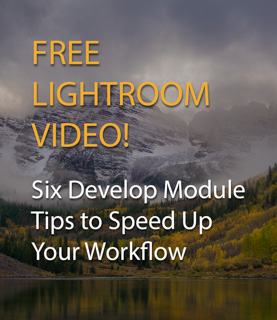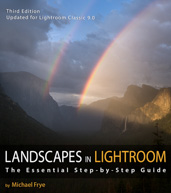In the Moment:
Michael Frye's Landscape Photography Blog
by Michael Frye | Dec 20, 2013 | Photography Tips
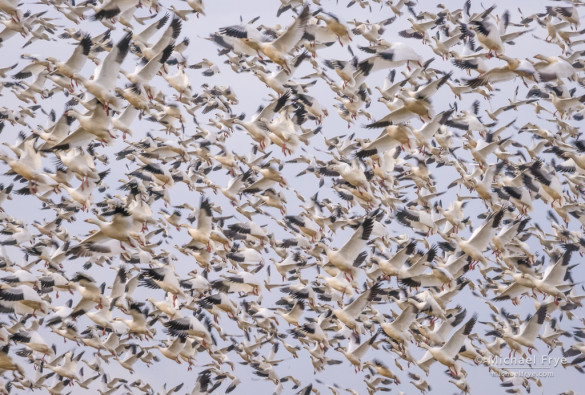
Formation of Ross’s geese taking flight, San Joaquin Valley, CA, USA; 1/250th sec. at f/16, ISO 800
On Wednesday Claudia and I rose early and drove down to the San Joaquin Valley. We spent most of the day photographing birds with our friends G Dan Mitchell, Patty Mitchell, David Hoffman, and Charlotte Hoffman, and had a wonderful time. The human company was great, and we found lots of my favorite bird subjects – the white Ross’s and snow geese.
While composition and light are always vital, some aspects of wildlife photography are very different from landscape photography. With wildlife the subjects are moving, placing greater importance on anticipation, timing, and the ability to make quick decisions about framing and camera settings.
(more…)
by Michael Frye | Dec 18, 2013 | Announcements, Vision and Creativity
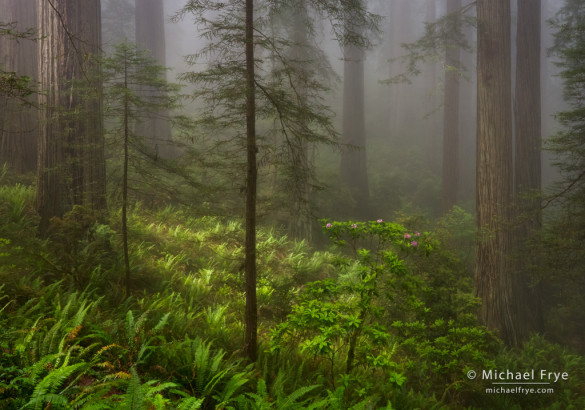
Redwoods, ferns, and rhododendrons near the northern California coast, USA
Continuing our look at back at the most popular posts of 2013, here’s one that’s been extremely popular – in fact it’s my most-read post ever. It’s from January 2013, and it’s called Creating Depth: Beyond the Wide-Angle Formula.
This post looks at some alternatives to the popular, wide-angle, near-far look that you see in so many landscape photographs – alternatives like atmospheric effects, subtle perspective clues, and size comparisons. And the article also explains why many photographs and paintings with a sense of depth have something in common that’s not immediately obvious.
To all of you who read this article, commented, or wrote me an email response, thanks very much! Your participation makes writing this blog fun, and I know your comments make reading it more enjoyable for everyone.
— Michael Frye
Michael Frye is a professional photographer specializing in landscapes and nature. He is the author or principal photographer of The Photographer’s Guide to Yosemite, Yosemite Meditations, Yosemite Meditations for Women, and Digital Landscape Photography: In the Footsteps of Ansel Adams and the Great Masters. He has also written three eBooks: Light & Land: Landscapes in the Digital Darkroom, Exposure for Outdoor Photography, and Landscapes in Lightroom 5: The Essential Step-by-Step Guide. Michael written numerous magazine articles on the art and technique of photography, and his images have been published in over thirty countries around the world. Michael has lived either in or near Yosemite National Park since 1983, currently residing just outside the park in Mariposa, California.
by Michael Frye | Dec 15, 2013 | Announcements
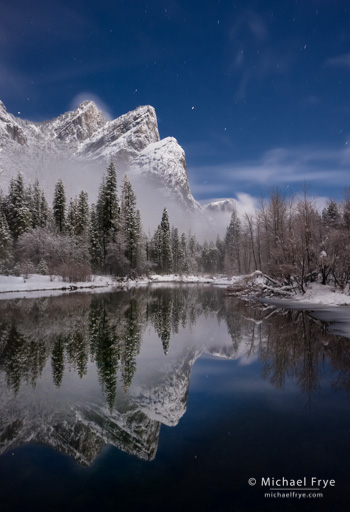
Three Brothers reflected in the Merced River on a moonlit night, Yosemite NP, CA, USA
As we count down to the new year, I thought this might be a good time to look back at my most popular blog posts of 2013. We’ll start with a post from early January of this year showcasing my best images from 2012, as chosen by you, my readers. The top vote-getter, by a wide margin, was this photograph of Three Brothers by moonlight, but you can see all of the top ten for 2012 here, and see all the original nominees here.
I’ll be doing this again – letting my readers pick my best images from 2013. But the year isn’t over yet, and there’s still time for me to make a few more photographs, so look for the post with the nominees after the first of the year. And in the meantime I look forward to highlighting more of my top articles from this year, including the most popular ever next time.
Thanks to all of you for helping to make this a great year, and Happy Holidays!
— Michael Frye
Related Posts: 2012: My Top Ten Images; 2012: Picking My Best Images
Did you like this article? Click here to subscribe to this blog and get every new post delivered right to your inbox!
Michael Frye is a professional photographer specializing in landscapes and nature. He is the author or principal photographer of The Photographer’s Guide to Yosemite, Yosemite Meditations, Yosemite Meditations for Women, and Digital Landscape Photography: In the Footsteps of Ansel Adams and the Great Masters. He has also written three eBooks: Light & Land: Landscapes in the Digital Darkroom, Exposure for Outdoor Photography, and Landscapes in Lightroom 5: The Essential Step-by-Step Guide. Michael written numerous magazine articles on the art and technique of photography, and his images have been published in over thirty countries around the world. Michael has lived either in or near Yosemite National Park since 1983, currently residing just outside the park in Mariposa, California.
by Michael Frye | Dec 13, 2013 | Photography Tips, Yosemite Photo Conditions
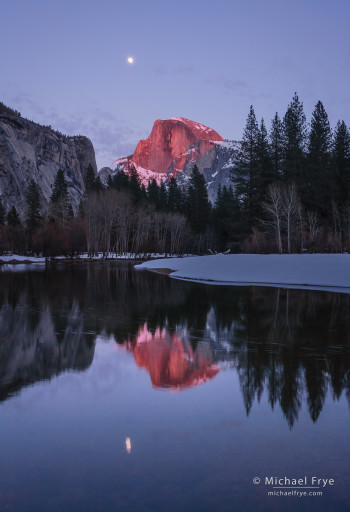
Half Dome and moon at sunset, February 18th, 2008
There’s something magical about the moon. Putting the moon in a photograph adds a sense of mystery and timelessness, and can elevate an otherwise ordinary scene into something special. Ansel Adams confessed to being “moonstruck,” and I suppose I am too.
The moon will be full next Tuesday (at 1:28 a.m. here on the west coast), and I’m sure many photographers will be trying to capture a rising or setting moon during the coming days, so I thought I would share some ideas about photographing the full moon, and clear up some misconceptions.
Misconception #1
One misconception is that moonrise or moonset photos are taken at night. They’re not: they’re almost invariably made near sunrise or sunset. After dark the contrast between the moon and the landscape is too great, and a good exposure for the moon will make the landscape completely black, while a good exposure for the landscape will wash out the moon. Around sunrise and sunset it’s possible to balance the light between the moon and the landscape and get detail in both, yet have a dark enough sky for the moon to stand out clearly.
Misconception #2
Another misconception is that moonrise or moonset photos are made on the date when your calendar says “full moon.” This can work if the terrain is flat, or you’re at a high vantage point. But if there are mountains or ridges blocking your view of the horizon, you’re better off photographing a moonrise one to three days before the full moon, and a moonset one to three days after the full moon. While the moon won’t technically be full, it will look full enough, and be in a better position than on the actual full moon night. Here’s why:
(more…)
by Michael Frye | Dec 6, 2013 | Reviews
I love ebooks; I’ve written three of them, and I think they’re great for teaching and learning about photography. But there’s something special about a beautiful, well-printed, coffee-table book. Picking one up is like holding an art exhibit in your hands, and the tactile sensations of turning the pages complement the visual experience of looking at the images. So here are four actual, physical books you might not have seen before, but that could make great gifts this holiday season.
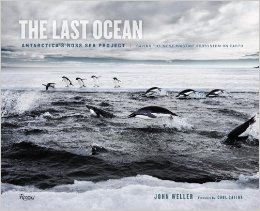 The Last Ocean:
The Last Ocean:
Antarctica’s Ross Sea Project
by John Weller
Rizzoli
John Weller might be one of the best nature photographers you’ve never heard of. I first met John in the 1990s when he worked briefly at The Ansel Adams Gallery in Yosemite. John has since gone on to create two beautiful books: Great Sand Dunes National Park: Between Light and Shadow, and his latest, The Last Ocean.
The Last Ocean is part of an ambitious project to document and preserve Antarctica’s Ross Sea, considered to be the most pristine ecosystem left on earth. John made four separate trips to this area and came back with a stunning collection of beautiful and imaginative photographs. And, in something of a rarity for a coffee-table book, the text is as compelling as the photographs, with vivid descriptions of the area, the lives of the animals, and of John’s adventures.
To see some of the photographs in the book, check out this slide show. You can order signed copies of the book directly from John, or get unsigned copies from Amazon.
(more…)
by Michael Frye | Dec 5, 2013 | Photography Tips
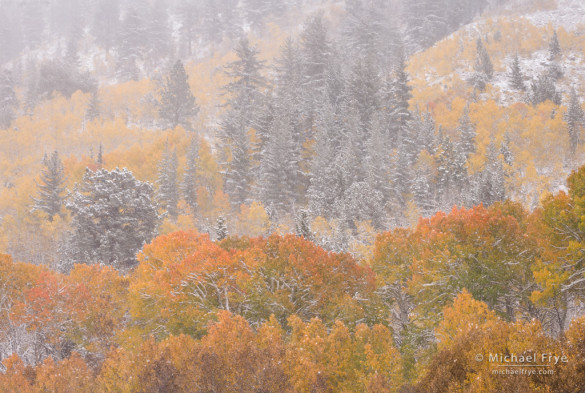
Aspens and pines in an autumn snowstorm, Toiyabe NF, CA, USA; 1/8 sec at f/22, ISO 50
In October I fulfilled a long-time dream: to photograph autumn aspens in the snow. I posted one photograph from that snowy day here, and two more from the following morning here. But I made a lot of other images during that storm, and now finally have a chance to show you some of them.
On that snowy October day it was a challenge to keep my camera dry, keep snow and water drops off the lens, and stay warm myself. But it was a rare opportunity, and I didn’t want to wait until the snow stopped, because the falling snow itself gave the photographs an ethereal quality, almost like fog.
(more…)
by Michael Frye | Dec 1, 2013 | Vision and Creativity
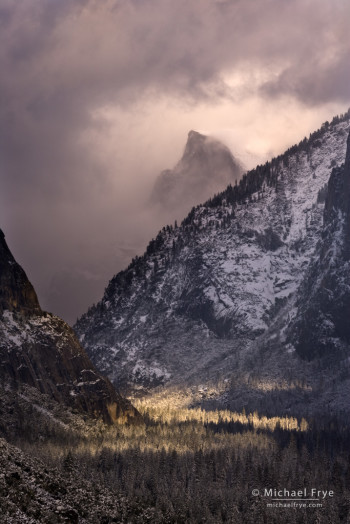
Half Dome and Yosemite Valley from Tunnel View, Yosemite NP, CA, USA
In a recent post I talked about adapting your composition to the light, rather than hoping that the light adapts to your composition. Nowhere is this more true than at Tunnel View. Sometimes the classic view – with El Capitan on the left, and Cathedral Rocks on the right – works perfectly. But not always. When I made this photograph the most interesting part of the scene was a small area in the distance where the light was hitting Half Dome and the valley floor below, so I zoomed in with my 70-200mm lens, turned the camera to a vertical orientation, and filled the frame with just those two spots.
Looking at this photograph made me think about clearing storms, and snow, and Christmas coming. I hope we get lots of snow this winter, not just for the sake of photographers, but for everyone in California. We’ve had two straight years of meager precipitation here, and we really need a wet winter. So let it snow!
— Michael Frye
Related Posts: Courting Luck: How to Take Advantage of Special Light and Weather in Landscape Photography; Courting Luck, Part 2: Adapting Your Composition to the Conditions; A Beautiful Week in Yosemite
Did you like this article? Click here to subscribe to this blog and get every new post delivered right to your inbox!
Michael Frye is a professional photographer specializing in landscapes and nature. He is the author or principal photographer of The Photographer’s Guide to Yosemite, Yosemite Meditations, Yosemite Meditations for Women, and Digital Landscape Photography: In the Footsteps of Ansel Adams and the Great Masters. He has also written three eBooks: Light & Land: Landscapes in the Digital Darkroom, Exposure for Outdoor Photography, and Landscapes in Lightroom 5: The Essential Step-by-Step Guide. Michael written numerous magazine articles on the art and technique of photography, and his images have been published in over thirty countries around the world. Michael has lived either in or near Yosemite National Park since 1983, currently residing just outside the park in Mariposa, California.
by Michael Frye | Dec 1, 2013 | Announcements
Just a reminder that there are less than 36 hours left in our Black Friday Sale, with 35% off my Landscapes in Lightroom 5 ebook and video package, and 40% off The Photographer’s Guide to Yosemite iPhone and iPad app. The sale ends at midnight Pacific time tomorrow, December 2nd. Again, you don’t need to enter any special codes – those are just the prices until the sale is over.
I hope everyone had a great holiday weekend!
— Michael Frye
by Michael Frye | Nov 29, 2013 | Announcements

Yes, we’re having a Black Friday sale too! Here at our world headquarters in downtown Mariposa, California, we’ve cooked up two sweet deals:
35% Off Landscapes in Lightroom 5: The Essential Step-by-Step Guide
Normally $14.95, this ebook and video package is now only $9.95! You don’t have to enter a discount code – that’s just the price until midnight Pacific Time on Monday, December 2nd.
In this ebook I take you step-by-step through processing six images in Lightroom. You can download the Raw files so you can follow along yourself, plus you get exclusive access to eight videos demonstrating different aspects of Lightroom’s Develop Module.
This is a great gift for the photographer on your Christmas list! Just click “Add to Cart” underneath the words “Gift Coupon.”
40% Off The Photographer’s Guide to Yosemite iPhone/iPad App
This app is a must-have for any photographer visiting Yosemite. Normally it sells for $6.99, but until midnight Pacific Time on December 2nd it’s only $3.99! Click here to go to the iTunes store, and once again there are no discount codes you need to enter.
(more…)
by Michael Frye | Nov 27, 2013 | Announcements
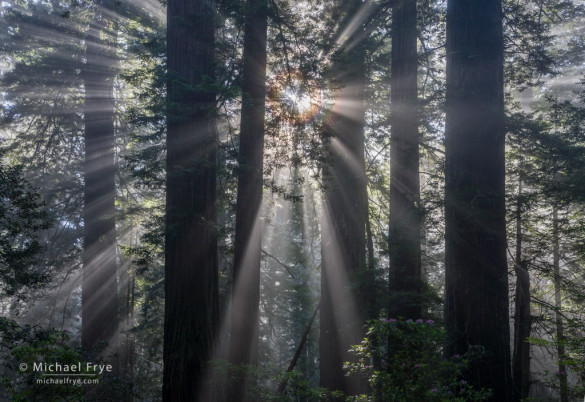
Sunbeams and corona in a redwood forest, CA, USA
Tomorrow is Thanksgiving here in the United States, a day of gratitude.
As a photographer, one of the things I’m thankful for is the art and craft of photography itself. Photography encourages me to get out and see things I would otherwise miss. I’ve been lucky to witness so many extraordinarily beautiful moments that I would never have seen without the camera tugging at me and telling me to go look – to pay attention to the beauty around me.
And I’m always especially thankful for all of you, my readers. Your participation, ideas, and passion for photography make writing this blog a pleasure. Thank you so much for your support!
I hope all of you have a wonderful holiday, filled with good company, good food, and many things to be grateful for.
— Michael Frye










